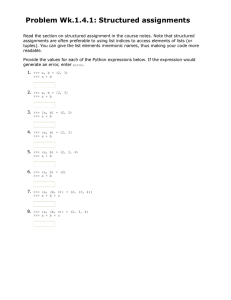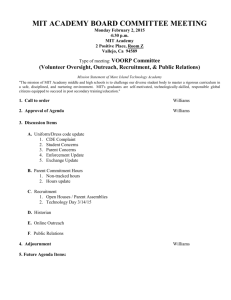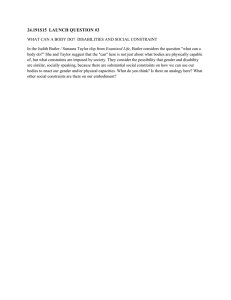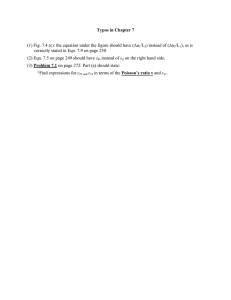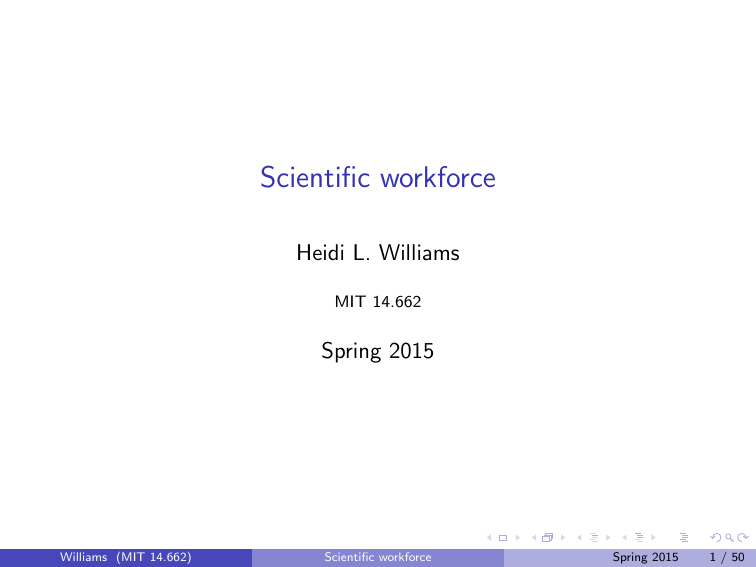
Scientific workforce
Heidi L. Williams
MIT 14.662
Spring 2015
Williams (MIT 14.662)
Scientific workforce
Spring 2015
1 / 50
The economics of science
Excellent general reference: Paula Stephan’s 2012 book
How Economics Shapes Science
Chapter 7: market for scientists and engineers
�
�
�
�
Gestation (training) period is quite long
Job prospects at time of graduation difficult to predict in advance
Aspirants often lack information on job outcomes of recent graduates
She argues that career decisions in this market may largely be made in
the dark due to scientists’ “love” of the subject
Today: focus on two papers investigating some of these issues
1
2
Borjas-Doran (2012)
Stern (2004)
Williams (MIT 14.662)
Scientific workforce
Spring 2015
2 / 50
1
Roy model (loosely defined!): Borjas-Doran (2012)
2
Compensating differentials
Stern (2004)
Linking back to theory: Aghion et al. (2008)
Linking back to empirics: Murray et al. (2012)
3
Looking ahead
Williams (MIT 14.662)
Scientific workforce
Spring 2015
3 / 50
Borjas-Doran (2012)
Investigate how a large, post-1992 influx of Soviet mathematicians
affected the (publication) productivity of US mathematicians
Key idea: prior to collapse of Soviet Union, little collaboration and
infrequent exchanges between Soviet and Western mathematicians;
after collapse of Soviet Union, ∼ 1, 000 Soviet mathematicians
migrated to other countries, and many mathematicians who stayed
became part of the globalized publication market
Williams (MIT 14.662)
Scientific workforce
Spring 2015
4 / 50
Historical context
Following establishment of Soviet Union in 1922, long period of
development of ideas independent from Western ideas
To varying degrees between 1922 and 1992, Soviet government
instituted strict controls on:
�
I
�
I
I
�
I
�
Which scientists could communicate with Western peers
Parameters of scientific travel
Acceptable outlets for publication
Access to Western research materials
Williams (MIT 14.662)
Scientific workforce
Spring 2015
5 / 50
Figure 1A: Differences in specialization
© Oxford University Press. All rights reserved. This content is excluded from our Creative
Commons license. For more information, see http://ocw.mit.edu/help/faq-fair-use/.
Williams (MIT 14.662)
Scientific workforce
Spring 2015
6 / 50
Figure 1B: Differences in specialization (continued)
© Oxford University Press. All rights reserved. This content is excluded from our Creative
Commons license. For more information, see http://ocw.mit.edu/help/faq-fair-use/.
Williams (MIT 14.662)
Scientific workforce
Spring 2015
7 / 50
Figure 2: Soviet / US collaborations
© Oxford University Press. All rights reserved. This content is excluded from our Creative
Commons license. For more information, see http://ocw.mit.edu/help/faq-fair-use/.
Williams (MIT 14.662)
Scientific workforce
Spring 2015
8 / 50
Figure 3: Aggregate employment statistics
© Oxford University Press. All rights reserved. This content is excluded from our Creative
Commons license. For more information, see http://ocw.mit.edu/help/faq-fair-use/.
Williams (MIT 14.662)
Scientific workforce
Spring 2015
9 / 50
Data
Construct a data set on authorship of every mathematics paper published
over past 70 years based on a databases from the American Mathematical
Society (AMS), supplemented by archives from Thomson Reuters ISI Web
of Science and Mathematics Genealogy Project
What was difficult about this:
Unique researcher IDs (incentives to curate)
Institutional locations (not always reported)
Citation outcomes (data accuracy)
Williams (MIT 14.662)
Scientific workforce
Spring 2015
10 / 50
Table 1: Positive selection of migrants
© Oxford University Press. All rights reserved. This content is excluded from our Creative
Commons license. For more information, see http://ocw.mit.edu/help/faq-fair-use/.
Williams (MIT 14.662)
Scientific workforce
Spring 2015
11 / 50
Figure 7: Event study for productivity
© Oxford University Press. All rights reserved. This content is excluded from our Creative
Commons license. For more information, see http://ocw.mit.edu/help/faq-fair-use/.
Williams (MIT 14.662)
Scientific workforce
Spring 2015
12 / 50
Take-aways
Really cool that you can see the effects in aggregate
Thoughtful, careful data construction
Attempt to get at a variety of related questions
Welfare is hard to assess here
Williams (MIT 14.662)
Scientific workforce
Spring 2015
13 / 50
1
Roy model (loosely defined!): Borjas-Doran (2012)
2
Compensating differentials
Stern (2004)
Linking back to theory: Aghion et al. (2008)
Linking back to empirics: Murray et al. (2012)
3
Looking ahead
Williams (MIT 14.662)
Scientific workforce
Spring 2015
14 / 50
Stern (2004): Motivation
Aims to understand incentives shaping knowledge production
Input into innovation, economic growth
“Science” (Dasgupta-David 1994, Merton 1973)
Incentive system
Researchers offered substantial discretion in choosing projects
Rewards based on establishing intellectual priority
Journal publications
Williams (MIT 14.662)
Scientific workforce
Spring 2015
15 / 50
Why might a science-oriented approach be pursued?
1
Scientists may have a “taste” for science. Researchers may have
preferences for interacting with discipline-specific communities and for
receiving recognition for their discoveries. Stern refers to this as the
“preference effect.”
�
I
�
I
2
Some of you seem skeptical :)
Example: economists
Science may have productivity benefits, especially for firms. Firms
may adopt science-oriented approach to increase R&D productivity.
Stern refers to this as the “productivity effect.”
Williams (MIT 14.662)
Scientific workforce
Spring 2015
16 / 50
Comparing/contrasting these two explanations
No inherent conflict: scientists may have a taste for participating in
science (preference), and some firms may find it worthwhile to
participate in science (productivity)
But: different implications for scientific labor market
�
I
Preference: negative association between science, wages
*
�
I
Compensating differential
Productivity: positive association between science, wages
*
As long as there is “rent-sharing” between firms, researchers
(e.g. Van Reenen 1996)
Williams (MIT 14.662)
Scientific workforce
Spring 2015
17 / 50
Selection
In observational data, also expect selection. Why?
“Winner-take-all” nature of scientific reward system
⇒ benefits to science are higher for higher-ability researchers
�
I
�
I
I
�
Higher ability scientists will have a higher preference for science
Higher ability scientists may use some of their higher earnings capacity
to “purchase” science: cov (SCI , Ai ) > 0
Firms employing higher ability scientists will adopt science
(Zucker and Darby 1996; Zucker, Darby, Brewer 1998)
Some aspects of individual productivity likely unobserved
Unobserved ability ⇒ more science, higher wages
Williams (MIT 14.662)
Scientific workforce
Spring 2015
18 / 50
Conceptual framework
Rosen-style model (e.g. inelastic labor supply)
Two stages
�
I
I
�
Stage 1: firm j chooses SCI = 1 or SCI = 0
Stage 2: firm j hires a single researcher with ability γi
γi : unobserved by econometrician
I
�
I
�
Drawn from firm-specific distribution gj (γ)
Bounded below at zero with mean γ̄j
Assume scientists of higher ability place higher value on SCI
Scientists’ utility depends on offered wage + preference for SCI :
Ui = λ0 + αs γi SCIj + wj
Williams (MIT 14.662)
Scientific workforce
Spring 2015
19 / 50
Conceptual framework (continued)
Firms earn profits as a function of the ability of hired scientists, the wages
paid (wj ), and their science-orientation (note: fixed fee δ):
πi,j = γi (β0 + βs SCIj ) − wi,j − δSCIj
SCI = 1 firms earn quasi-rent: φ ∈ (0, 1) shared with scientists
∗
wi,j
= γi β0 + γi (φβs − αs )SCIj
If compensating differential αs is larger than part of quasi-rent extracted
by scientist, then wages will be decreasing in SCI
Possible that the preference effect reflects career concerns
(still an alternative to the productivity hypothesis)
Williams (MIT 14.662)
Scientific workforce
Spring 2015
20 / 50
Key idea: multiple job offers
Stern’s key insight: in job markets for “novice” professionals, many
candidates receive multiple job offers prior to accepting an offer
For candidates receiving multiple offers, can construct different points on
wage-amenity curve for a given worker at a given time.
Important: job offers confer legal responsibility on the firm ⇒ firm is
willing to employ worker, probability of acceptance is non-zero
Williams (MIT 14.662)
Scientific workforce
Spring 2015
21 / 50
Key assumptions
Assumes observed job offers are comparable in “seriousness”
(presents some tests of this assumption)
Assumes candidates who receive multiple offers are drawn
independently from the distribution of candidates
(presents some tests of this assumption)
Assumes scientific orientation is uncorrelated with alternative
unobserved sources of variation in R&D productivity
(tried his best to design survey to avoid this problem)
Assumes differences in firms’ information about candidates is
uncorrelated with scientific orientation
Williams (MIT 14.662)
Scientific workforce
Spring 2015
22 / 50
Data: self-run survey
“Final” offers to biology PhDs completing first post-doc
�
I
Sample: post-docs in job market for long-term employment
Small sample: 164 offers to 66 PhDs receiving multiple offers
�
I
I
�
I
�
Stern also examines data on individuals receiving a single offer:
223 offers to 107 PhDs receiving any offer
90% of the sample receives between 2 and 4 offers
Offer-level regression (individuals can appear more than once)
Williams (MIT 14.662)
Scientific workforce
Spring 2015
23 / 50
Key variables
Key variables are SALARY (baseline salary) and a series of variables
measuring scientific orientation of the employers:
1
PERMIT PUB: are researchers allowed to publish discoveries?
2
INCENT PUB: how strong are incentives for publication?
3
CONTINUE RESEARCH: are researchers allowed to continue
postdoctoral research projects?
4
SCIENCE INDEX: principal factor of the three above variables
Unobserved job attributes? Tried his best in survey design...
Williams (MIT 14.662)
Scientific workforce
Spring 2015
24 / 50
Table 1: Summary statistics
© Courtesy of Institute for Operations Research and the Management Sciences (INFORMS).
All rights reserved. This content is excluded from our Creative Commons license. For more
information, see http://ocw.mit.edu/help/faq-fair-use/.
Williams (MIT 14.662)
Scientific workforce
Spring 2015
25 / 50
Table A1: Correlations
Measures of scientific orientation are correlated with each other;
motivates composite index
© Courtesy of Institute for Operations Research and the Management Sciences (INFORMS).
All rights reserved. This content is excluded from our Creative Commons license. For more
information, see http://ocw.mit.edu/help/faq-fair-use/.
Williams (MIT 14.662)
Scientific workforce
Spring 2015
26 / 50
Summary of main results
Cross-section estimate “wrong-signed”
With FE: Science-oriented offers associated with lower wages
�
I
Robust to controls for job types
*
�
I
How good are these controls?
Robust to restricting the sample to non-academic jobs
*
Important b/c academia is different on many dimensions
Internal/external validity checks:
I
�
I
�
Accepted and rejected job offers are comparable
Single and multiple offer candidates look similar
Williams (MIT 14.662)
Scientific workforce
Spring 2015
27 / 50
Table 2: Descriptive evidence
© Courtesy of Institute for Operations Research and the Management
Sciences (INFORMS). All n rights reserved. This content is excluded
from our Creative Commons license. For more information, see
http://ocw.mit.edu/help/faq-fair-use/.
Williams (MIT 14.662)
Scientific workforce
Spring 2015
28 / 50
Table 3: Estimates of equalizing wage differential
© Courtesy of Institute for Operations Research and the Management Sciences (INFORMS).
All rights reserved. This content is excluded from our Creative Commons license. For more
information, see http://ocw.mit.edu/help/faq-fair-use/.
Williams (MIT 14.662)
Scientific workforce
Spring 2015
29 / 50
Table 4: Estimates of equalizing wage differential
Sample limited to non-academic offers
© Courtesy of Institute for Operations Research and the Management
Sciences (INFORMS). All n rights reserved. This content is excluded
from our Creative Commons license. For more information, see
http://ocw.mit.edu/help/faq-fair-use/.
Williams (MIT 14.662)
Scientific workforce
Spring 2015
30 / 50
Table 5: Relating salary to job amenities
© Courtesy of Institute for Operations Research and the Management
Sciences (INFORMS). All n rights reserved. This content is excluded
from our Creative Commons license. For more information, see
http://ocw.mit.edu/help/faq-fair-use/.
Williams (MIT 14.662)
Scientific workforce
Spring 2015
31 / 50
Table 6a: Individuals receiving single vs. multiple offers
Could imagine doing more here
© Courtesy of Institute for Operations Research and the Management Sciences (INFORMS).
All rights reserved. This content is excluded from our Creative Commons license. For more
information, see http://ocw.mit.edu/help/faq-fair-use/.
Williams (MIT 14.662)
Scientific workforce
Spring 2015
32 / 50
Table 6b: Comparing accepted and rejected offers
More direct test than ACCEPTED regression control variable
© Courtesy of Institute for Operations Research and the Management Sciences (INFORMS).
All rights reserved. This content is excluded from our Creative Commons license. For more
information, see http://ocw.mit.edu/help/faq-fair-use/.
Williams (MIT 14.662)
Scientific workforce
Spring 2015
33 / 50
Take-aways
Scientists seem willing to pay to do science
New methodology: has limitations, but very innovative
Are there better/different ways to get at this idea?
Substantively interesting context
Economists? Doctors? Lawyers? Programmers?
Williams (MIT 14.662)
Scientific workforce
Spring 2015
34 / 50
1
Roy model (loosely defined!): Borjas-Doran (2012)
2
Compensating differentials
Stern (2004)
Linking back to theory: Aghion et al. (2008)
Linking back to empirics: Murray et al. (2012)
3
Looking ahead
Williams (MIT 14.662)
Scientific workforce
Spring 2015
35 / 50
Linking back to theory
Aghion, Dewatripont, and Stein (2008) take Stern’s compensating wage
differential as a “fact” motivating a model clarifying the advantages and
disadvantages of academic and private research
“Usual” case for (government funding of) academic research:
knowledge spillovers not fully appropriable ⇒ underinvestment
�
I
Could solve that market failure with stronger property rights
A-D-S: alternative reasoning generating a role for academia
I
�
Suggests stronger property rights may not be optimal
Williams (MIT 14.662)
Scientific workforce
Spring 2015
36 / 50
Academic vs. private-sector research
Key distinction emphasized between academia and private sector:
tradeoff between creative control and focus
Academia: scientists retain decision rights over what projects to take
on, and what methods to use in tackling these projects
Private sector: decision rights reside with owner/manager of the firm,
who can (and will) largely dictate project choice and methods to
individual scientists who work for the firm
If scientists value creative control (cite as evidence: Stern 2004), they will
have to be paid a wage premium in order to give it up
Williams (MIT 14.662)
Scientific workforce
Spring 2015
37 / 50
Implications
One advantage of academia: labor is cheaper
One disadvantage of academia: scientists may work on projects they
find interesting but which have little economic value; in contrast,
given control rights firms can direct scientists to work on the most
commercially valuable projects
In the A-D-S model, the resolution of this tradeoff depends on how far
from commercialization a particular line of research is
Williams (MIT 14.662)
Scientific workforce
Spring 2015
38 / 50
Example
Line of biotech research with 10 stages which will yield a drug worth $10
billion ⇐⇒ all ten stages are successfully completed
Final stage. Moving project ahead: private directedness
First stage. Expected payoff is smaller: cede creative control in order
to economize on scientists’ wages
These basic ideas clarify why it may be socially optimal to have
early-stage, basic research occur in academia
(Most) interesting extension - “branching out”: projects may be positive
NPV at academic wages but not at private-sector wages ⇒
under-investment in basic research
Williams (MIT 14.662)
Scientific workforce
Spring 2015
39 / 50
Technology
I0 : initial idea (followed by I1 , I2 , ...: k stages)
Ik : final idea, marketable product with value V
Probability of success at stage i depends on:
1
2
Number of active scientists at that stage (n)
Research strategies they pursue:
*
*
“Practical”: maximizes probability that current idea Ij−1 will be refined
into Ij ; if all n pursue “practical,” probability is φ(n)
“Alternative”: puzzle-solving (no immediate payoff)
For practical strategy:
�
I
I
�
I
�
Main results assume φ(n) = p ∀n ≥ 1, φ(0) = 0
Assumes all scientists pursuing practical have a perfectly correlated
draw from same success distribution (⇒ n = 1)
Also look at case where n is endogenous
Williams (MIT 14.662)
Scientific workforce
Spring 2015
40 / 50
Scientists’ preferences
Infinite pool of scientists: can research in academia or in firms
�
I
Can’t be self-employed in science (fixed costs, no wealth)
Outside option R (taxi-driving): sets wage floor
Key assumption: scientists value creative independence
�
I
�
I
After seeing Ij−1 , each scientist decides preferred strategy for Ij
α: ex ante probability scientist prefers practical strategy for Ij
*
*
�
I
�
I
�
I
�
I
All scientists have the same preference at a given stage
Can be relaxed
z: disutility from working on non-preferred strategy
Ex ante firm promise of preferred strategy: wage of R
Ex ante firm promise of non-preferred strategy: wage of R + z
Risk-neutral scientists: paid a proportional wage premium
Williams (MIT 14.662)
Scientific workforce
Spring 2015
41 / 50
Academia
Precommitment to leave control over choice of research strategy in
the hands of individual scientists
�
I
Why? Discuss non-profit structure, monitoring costs
Characterization of outcome: n scientists at stage j
�
I
I
�
I
�
I
�
Scientists paid wa = R, work on preferred strategy
With probability α, all n work on practical strategy
With probability 1 − α, all n work on alternative strategy
Ex ante probability of reaching Ij+1 : αφ(n)
Williams (MIT 14.662)
Scientific workforce
Spring 2015
42 / 50
Private sector
Entrepreneurs, not scientists, fund projects
�
I
Entrepreneurs care about profits, not research strategies
Ex post, can force scientists to most profitable strategy
Scientists demand wage of wp = R + (1 − α)z
I
�
(1 − α)z: compensating differential
Williams (MIT 14.662)
Scientific workforce
Spring 2015
43 / 50
Single research line
Proposition 1. It cannot be value maximizing to have academia operate at
later stages than the private sector.
Proposition 2. A research program with a sufficiently large number of
stages won’t be viable if located exclusively in the private sector.
Proposition 3. Holding fixed the number of stages, it is optimal to have
the private sector transition occur earlier if (i) V is greater, or (ii) z is
smaller.
Williams (MIT 14.662)
Scientific workforce
Spring 2015
44 / 50
Branching out
Modify the model to assume that the alternative strategy may yield new
insights that may spawn wholly different lines of research
Assume private sector never has any use for offspring lines because
they are so early stage that they are negative NPV when evaluated at
private-sector wages
Assume offspring lines are viable if born in academia
Implies private sector ownership of an idea will not yield as diverse an
array of useful next-generation ideas as would academia
Williams (MIT 14.662)
Scientific workforce
Spring 2015
45 / 50
1
Roy model (loosely defined!): Borjas-Doran (2012)
2
Compensating differentials
Stern (2004)
Linking back to theory: Aghion et al. (2008)
Linking back to empirics: Murray et al. (2012)
3
Looking ahead
Williams (MIT 14.662)
Scientific workforce
Spring 2015
46 / 50
How does openness affect diversity of research?
Murray et al. (2012) examine two shifts away from private-sector
ownership for genetically engineered mice:
Cre-lox: 1998
Onco: 1999 (less dramatic)
Williams (MIT 14.662)
Scientific workforce
Spring 2015
47 / 50
1
Roy model (loosely defined!): Borjas-Doran (2012)
2
Compensating differentials
Stern (2004)
Linking back to theory: Aghion et al. (2008)
Linking back to empirics: Murray et al. (2012)
3
Looking ahead
Williams (MIT 14.662)
Scientific workforce
Spring 2015
49 / 50
Looking ahead
Discrimination: Theory
By Friday night: please comment on Goldin-Rouse (2000)
Williams (MIT 14.662)
Scientific workforce
Spring 2015
50 / 50
MIT OpenCourseWare
http://ocw.mit.edu
14.662 Labor Economics II
Spring 2015
For information about citing these materials or our Terms of Use, visit: http://ocw.mit.edu/terms .

